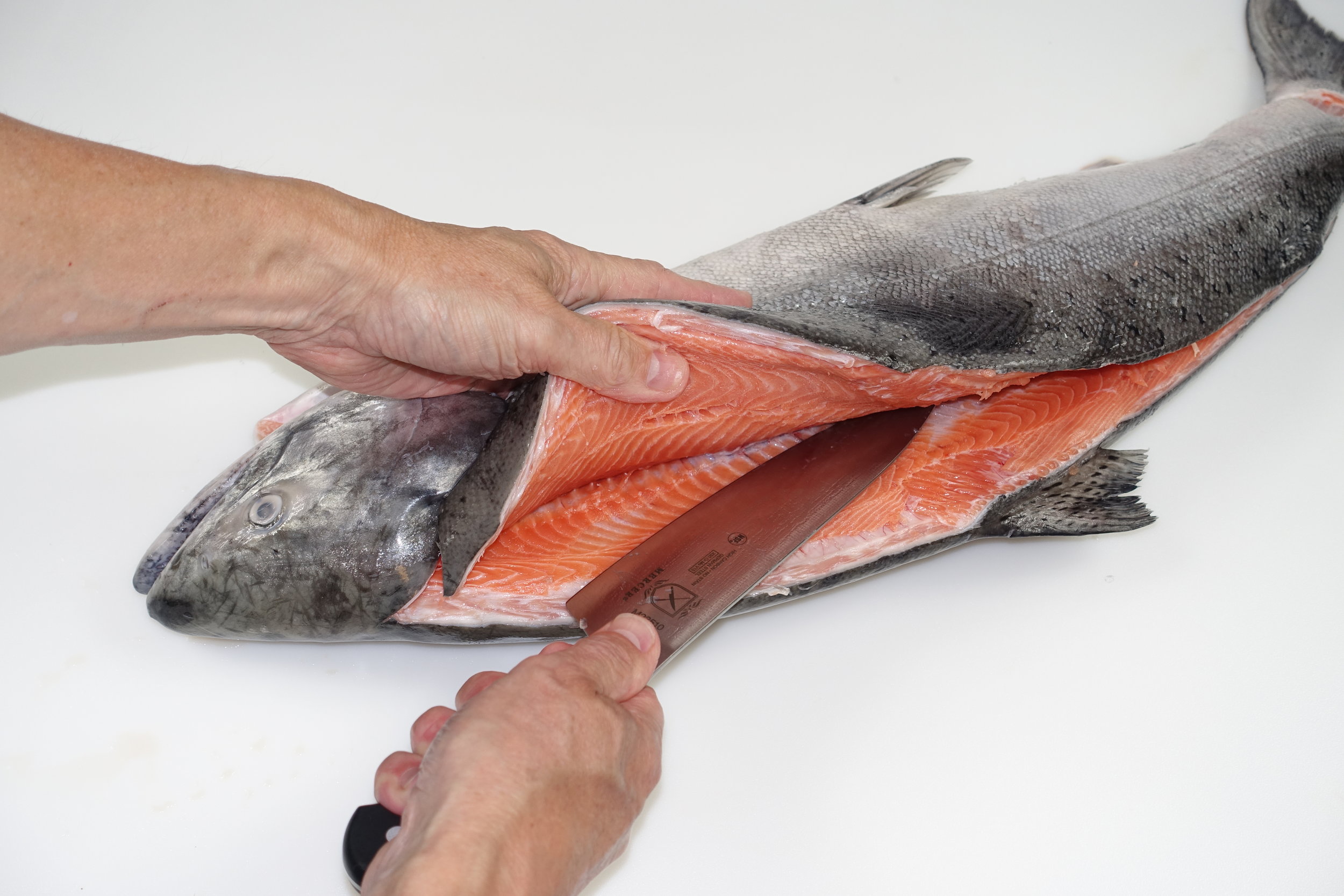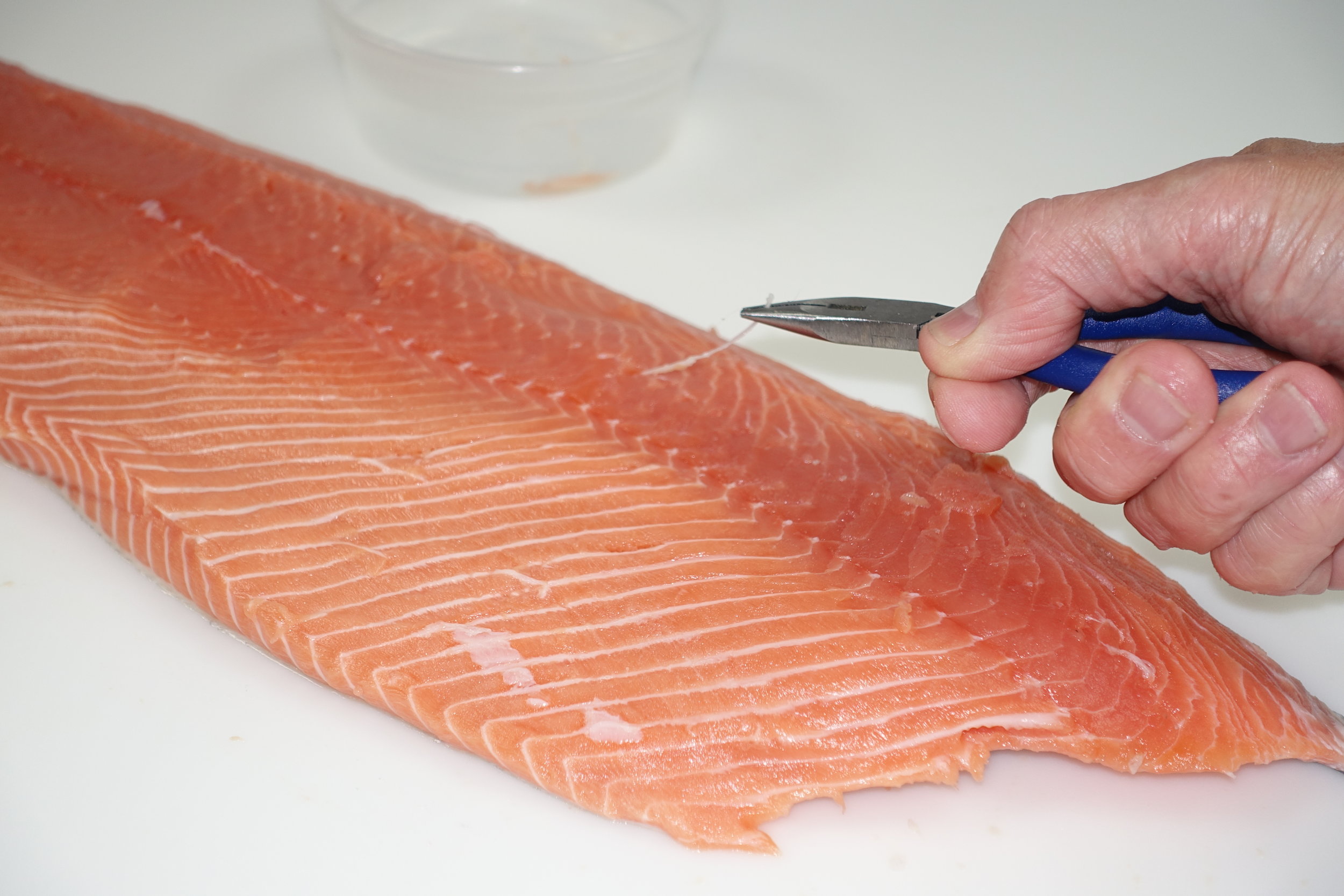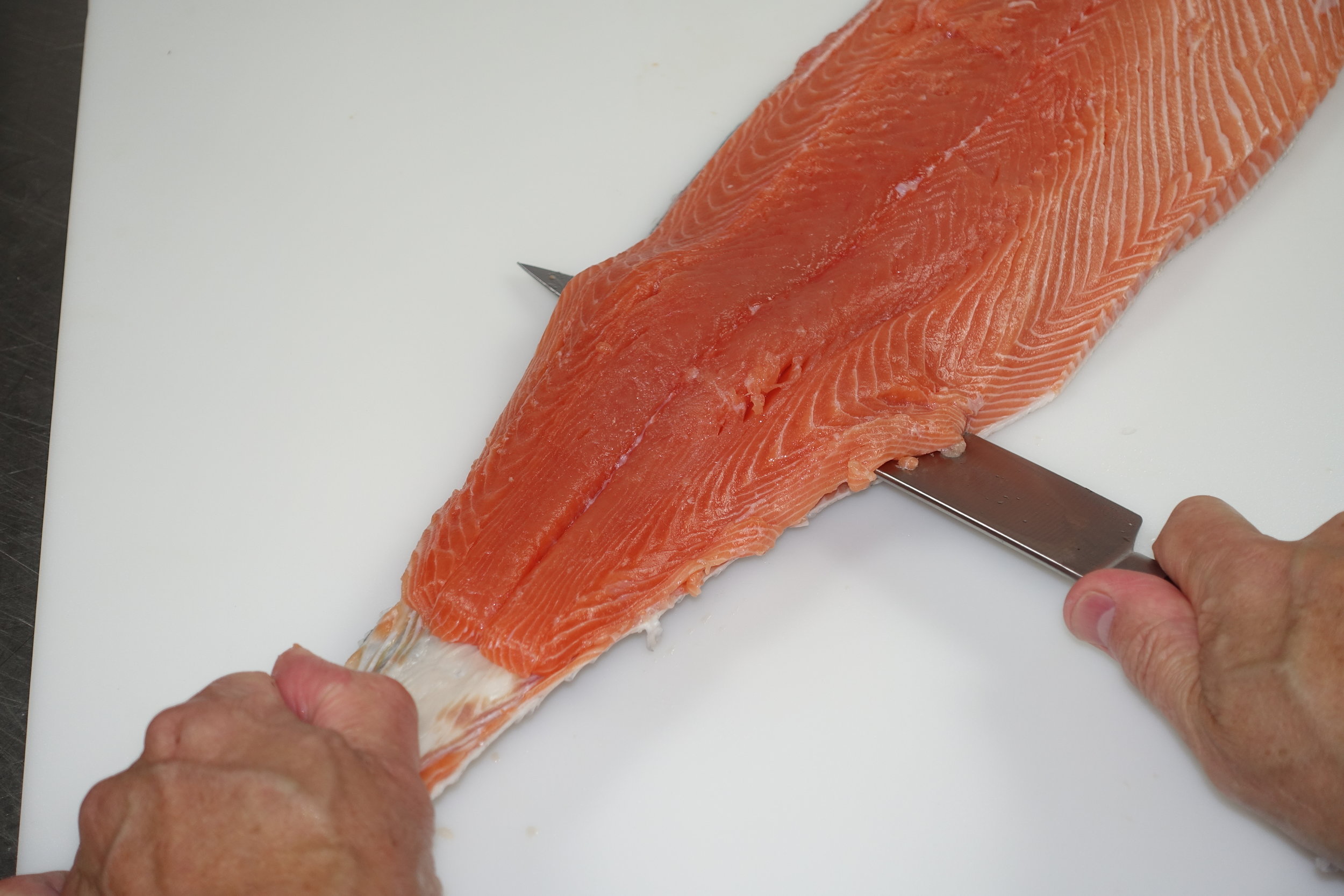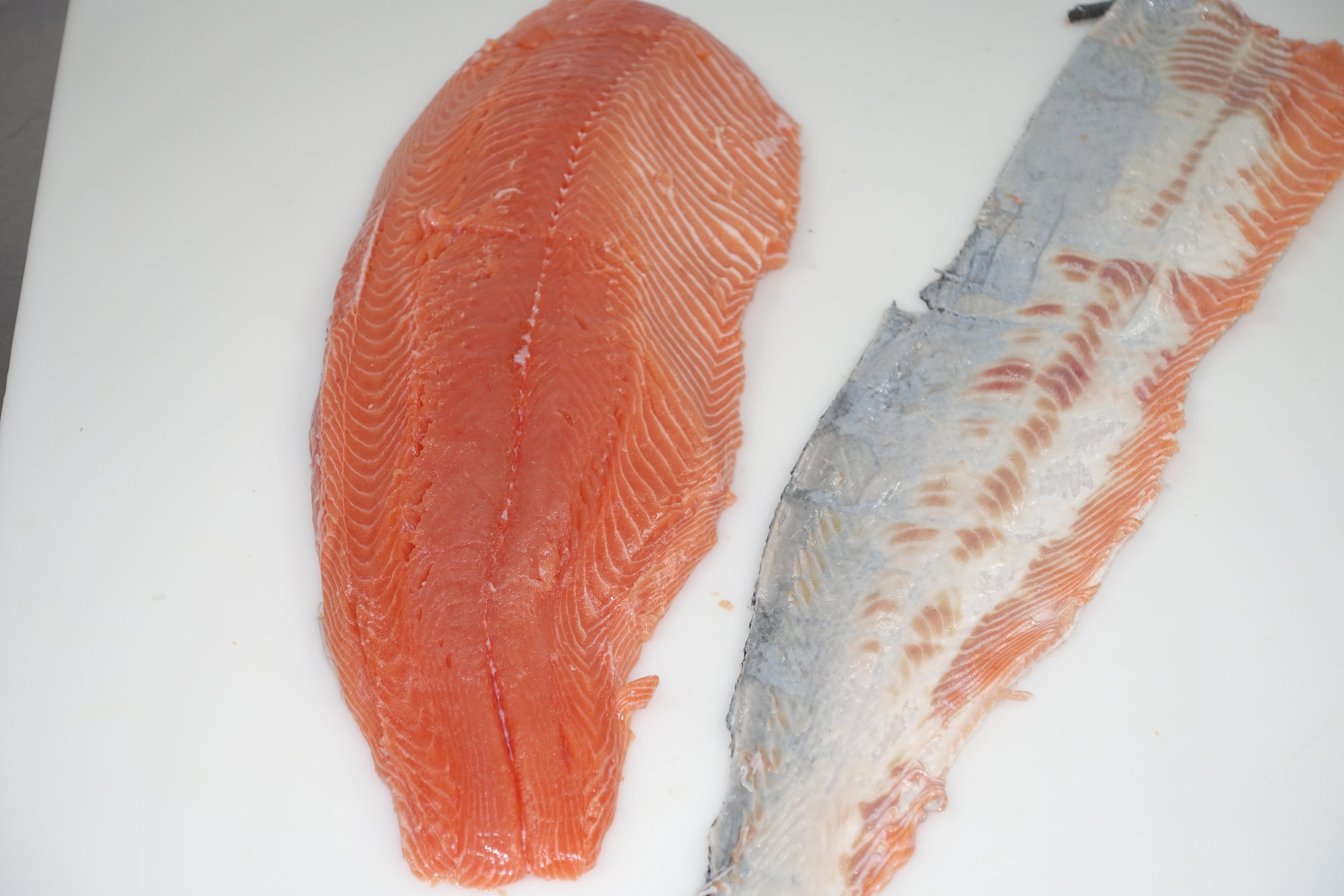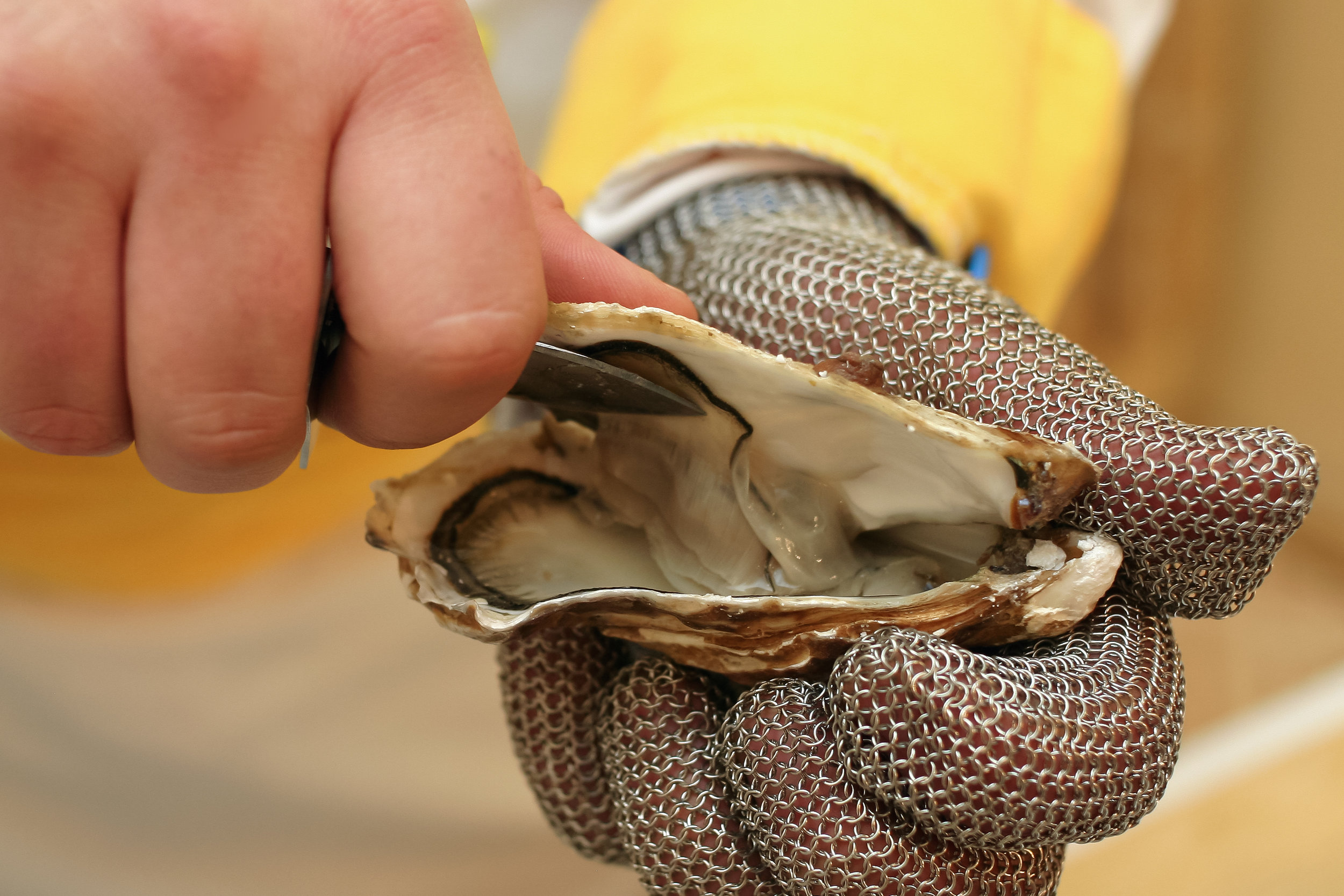Fish & Shellfish Fabrication
Fish Fabrication
Fish, unlike meats and poultry, are less complicated to butcher and portion but their soft flesh and delicate nature can also be ruined if not handled properly. Care in receiving, processing, and storing is important because their quality can deteriorate quickly if mishandled. Because fish and seafood command high market prices it pays to become knowledgeable in maximizing their value.
Fish Quality
Fish quality is largely based on the freshness of the product. Finding a reliable purveyor to provide superior fish and seafood is important for maintaining consistency in the kitchen. Whether the products are whole, fillets and sides, or portion-cut, look for a firm texture and fresh odor as signs of wholesomeness. Additional inspection includes a visual observation of the skin, belly, eyes, and gills. Look for a shiny skin that is tight to the carcass, gills that are red or pink and not brown, a belly cavity free of bruises or deterioration (also known as belly burn), and clear, bulging eyes not sunken or cloudy.
Fish often smell fishy because bacteria on the surface of the skin breaks down creating an off odor. Some species including sharks, skate, and rays urinate through their skin and can sometimes produce an ammonia smell. These odors can be counteracted to some extent by rinsing the fish and applying acids including lemon, vinegar, or tomato.
Storing Fresh Fish
It is important to keep fish as cold as possible especially during fabrication because it keeps the flesh firm and yields smooth, clean cuts. In a hot kitchen fish will warm up quickly causing the quality to deteriorate and the flesh to become soft and loose.
Holding fish on ice will prolong its shelf life too. Replenish ice as often as needed and always drain excess water from accumulating in the storage pan. Keeping the fish iced will provide a continuous rinsing action that minimizes odors and maximizes shelf life up to one week.
Fresh Fish Storage Tips
Keep fish cold and on ice at all times.
Fish will keep longer if left whole.
Whole fish should always be eviscerated before storing.
Fish should be held at a temperature of 29-32°F /-2°- 0°C.
Place fish in a perforated pan inserted in a drip pan for drainage of excess water.
Wrap fillets in plastic wrap when icing to prevent ice crystals from tearing the flesh of the fish.
It is best to use fresh fish within 2-3 days from delivery but whole fish can be held longer.
Frozen Fish
Frozen fish accounts for more volume of fish eaten today than fresh. The advantage of frozen fish is its convenience in holding and storage. The down-side to freezing fish, and most foods in general, is that during the process it causes water to expand and turn into crystals that burst the tissues of the fish. Once thawed, moisture is released from the fish softening the texture and drying it out. Thawed fish should never be refrozen because the texture will continue to deteriorate from subsequent freezing and thawing cycles. Rapid flash freezing under extremely cold temperatures results in smaller crystals and therefore less moisture purge when thawed. Previously frozen fish when thawed retains a “slacked out” quality that gives it a soft and wrinkled appearance.
Fabricating Fish
Fabricating whole fish should be viewed from a quality control perspective that’s fits with the philosophy of the establishment. It may not save the operation money if the kitchen crew lacks the expertise to process fish efficiently or if the the trim and bones aren't re-purposed for other preparations. Fish bones for example can be converted into fish stock, trimmings can be used for forcemeats, sausages, tartare, kabobs, stews and soups. Every attempt should be made to find creative ways to use the various parts because the price the restaurant pays for the fish is the same whether it’s served to the guest or is thrown in the trash.
Fish Fabrication Basics
Cutlery Tools for Fish Fabrication
Using the right tools will help to achieve high quality and better yields. Sharpen knives regularly and use a sharpening steel often during the fabrication process. Fish require precise clean cuts and a dull knife can easily tear the flesh and diminish the quality, leading to lower yields. A flexible filleting knife is an all-purpose utility knife that is useful when fabricating fish. Kitchen shears are handy for removing fins. Needle-nose pliers and tweezers are useful for removing pin bones from fillets.
Fish Fabrication Steps
Always sanitize the area before and after processing fish.
Scale and gut the fish if needed.
Trim fins with a kitchen shears
Remove the head by cutting through the fillet just behind the gills to the spine. Repeat the step on the opposite side and twist or cut off the head to finish.
Proceed with filleting or cross-cut into steaks.
Remove pin bones from the fillets with a needle nose plier.
Trim excess fat and skin the fillets if desired.
Remove the bloodline which can have an unpleasant taste.
Rinse in a mild saltwater solution.
Portion as desired
Once the fish is filleted the pin bones, found in round fish towards the front of the fillet, must be removed with a needle-nose pliers or by making a “V” or a "J" cut in the fillet.
Removing Pin Bones with
a Needle Nose Pliars
Skinning Fish
Fish are often skinned after they are filleted. In a few instances such as Dover Sole, the fish can be skinned whole before filleting. On some fish species the skin is left on and crisped when cooked for added texture.
Fish Portion Cuts
Once filleted, fish can be cut into desired sizes and shapes including escalopes, darnes or tranche (slices), or goujon/goujonette (fingers).
Shellfish Fabrication
Seafood is expensive and highly perishable, and must be handled with proper care to maintain their integrity. The qualities of fresh shellfish deteriorate quickly so mindful purchasing and careful inspection upon receiving deliveries is important. Maintaining proper storage temperatures and conditions also to minimizes costs and maximizes yields.
Quality Factors
Fresh shellfish are purchased in various forms including live, cleaned, or cooked and processed. In all cases fresh seafood should have a sweet and mild odor.
Live lobsters and crab will move actively when handled and not appear listless or limp; typical signs that they are dying or dead. Crustaceans may at times give off a strong odor of ammonia which indicates decomposition and therefore should be discarded.
Mollusks are living creatures and a good indication of their freshness is a tightly closed shell. If the shell is open a gentle tap should cause the shell to close. Mollusks whose shells remain open are dead and should be discarded.
Storing Shellfish
Live shellfish ideally should be stored in saltwater tanks. As an alternative they should be kept cold in containers that allow air circulation, with seaweed if possible, and covered with damp towels to keep them from drying out. Never store in airtight containers or plastic bags as this will suffocate them. Ideal temperatures are between 40˚F/4˚C-50˚F/10˚C and anything below that will kill them. Since they are saltwater creatures, ice is not recommended as the fresh water will speed their deterioration.
Shucked and cleaned shellfish including scallops, oysters, and clams should be kept on ice. However, avoid direct contact can damage their delicate flesh so it is best to cover with plastic wrap. Lobster tails, crab legs, and shrimp in their shells can be kept directly on ice similar to whole fish. Temperatures below 35°F will minimize bacterial growth and depending on their freshness can be held up to 7 days.
Frozen Shellfish
Lobster tails, shrimp, scallops and cooked crab are all available in frozen form. In fact there are vast arrays of shellfish that can be purchased in various forms for convenience purposes. Because of their highly perishable nature this may be preferable or the only choice if the operation is land-locked away from coastal waters.
Crustaceans
Lobster
Live lobsters in the United States are the North American variety and can be purchased live through most seafood vendors. It is important to visually inspect their health as they can quickly die in a matter of hours when removed from their saltwater environment. Listlessness is a warning sign that they should be cooked and processed immediately. Lobsters carry active protein-digesting enzymes in their guts and these enzymes will rapidly spread to the muscles and turn the tail meat mushy. This is often not recognized until they have been cooked. Lobster tomalley is the liver and pancreas of the lobster and although once considered a delicacy is now thought to contain too many contaminants to be eaten.
Shrimp
Although some shrimp can be purchased whole with the head intact, most shrimp are sold in a headless form either in the shell or shelled. The perishability of raw shrimp means that the most common market form is frozen. Shell-on shrimp require peeling and deveining.
Crab
Live crabs are a seasonal specialty found in coastal areas. Because crab is highly perishable it is most commonly purchased frozen as legs or claws and as cleaned crab meat. Soft-shell crabs, molting crabs that are available in the spring, are best when purchased live. They need to be cleaned of their gills, tails, and head before cooking.
Mollusks
Scrub and clean mollusks with a brush under cold-running water. Always check to see if they are alive and sort out bad ones before cooking. Soaking the shellfish for 30 minutes will help them to dispel sand and grit from their shells. Shucking clams and oysters should be done with a special knife and protective gloves to avoid accidents.
Clams
Like other mollusks, clams should be scrubbed and soaked prior to preparation. Fresh clams are usually prepared raw on the shell, baked, or steamed. Canned clams are often used in chowders and fritters.
Mussels
Most mussels marketed for consumption are farm-raised. They should be rinsed and scrubbed before cooking to remove any debris. Wild mussels have a “beard” of dark threads which helps them anchor and cling to rocks and reefs in the ocean. The beard should be removed in the cleaning process. Farmed mussels do not have a beard.
Oysters
Fresh oysters should be scrubbed before prepping as their rough exterior can contain dirt and grit. They are best shucked right before service as their quality will deteriorate quickly opened.
Scallops
Scallops in the shell command high prices and are usually found near coastal waters. Shucked and cleaned scallops are the most available forms in a fresh or frozen state. The crescent shape side muscle is made up of tough connective tissue and should be removed before cooking.
Cephalopods
Although cephalopods are mollusks, they require different methods of cleaning and handling. Most squid and octopus are purchased frozen but fresh varieties are seasonally available and well worth seeking out.
Octopus can be fabricated similar to squid. Removal of the beak and cartilage is done by separating the head from the tentacles.

